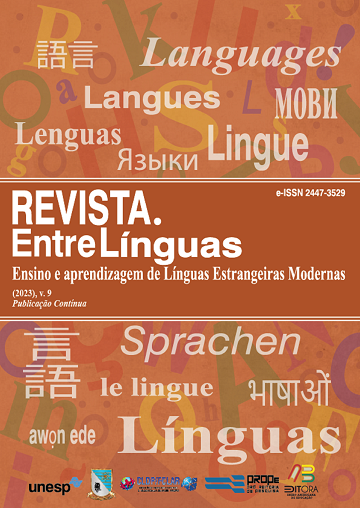Uma imagem ingênua do mundo e uma abordagem biosemântica para descrever a estrutura lexical de uma palavra
DOI:
https://doi.org/10.29051/el.v9i00.17640Palavras-chave:
Biossemiótica, Significado, Polissemia, Linguística cognitiva, Invariante lexicalResumo
Os problemas de estudar a estrutura lexical de uma palavra têm saída para várias áreas da ciência cognitiva, incluindo a biossemiótica. No artigo, a abordagem biossemiótica é reformulada em uma abordagem biossemântica baseada na decodificação de estruturas lexicais específicas. Os invariantes lexicais de palavras polissêmicas são mostrados como núcleos significativos de seus significados figurativos. É um conjunto de componentes semânticos dominantes que estão associados de forma estável com o significado de cada lexema. No processo de semiose, o indivíduo é guiado por esses componentes invariantes. Esses componentes são formados ao longo do tempo no nicho cognitivo do indivíduo como resultado das observações da relação entre os signos da linguagem. A parte prática do artigo inclui uma análise empírica de componentes invariantes do substantivo polissêmico inglês “a hood” do ponto de vista da semântica invariante. Diante dos resultados, a biossemiótica tem vantagem sobre a semântica tradicional na descrição da semântica das unidades lexicais.
Downloads
Referências
ALVES, F.; JAKOBSEN, A. L. (Eds.). The Routledge handbook of translation and cognition. Abingdon and New York: Routledge. 2021.
ANDREWS, E. Semiotic principles in cognitive neuroscience. Cognitive and Intermedial Semiotics, p. 1-10, 2019.
CARRERA-CASADO, D.; FERRER-I-CANCHO, R. The advent and fall of a vocabulary learning bias from communicative efficiency. Biosemiotics, v. 14, n. 2, p. 345-375, 2021.
ENDARA, L. et al. Building the “Plant glossary” - a controlled botanical vocabulary using terms extracted from the floras of North America and China. Taxon, v. 66, n. 4, p. 953-966, 2017.
KULL, K. The biosemiotic fundamentals of aesthetics: beauty is the perfect semiotic fitting. Biosemiotics, v. 15, n. 1, p. 1-22, 2022.
MATTHIESSEN, C. M. et al. Cognition in systemic functional linguistics. In: Systemic Functional Insights on Language and Linguistics. Singapore: Springer Singapore, 2022. p. 147-195.
MENANT, C. Constraint satisfaction, agency and meaning generation as an evolutionary framework for a constructive biosemiotics. In: Agency and Meaning Generation as an Evolutionary Framework for a Constructive Biosemiotics, 17 Feb. 2019.
NOVIKOV, D. N.; PESINA, S. A. Biosemiotics and Prototype Semantics in Understanding Lexical Polysemy: Implications for Applied Linguistics. The magic of innovation. New techniques and technologies in teaching foreign languages, v. 275, 2015.
PELKEY, J. Chiastic antisymmetry in language evolution. The American Journal of Semiotics, v. 29, n.1/4, p. 39-68, 2016.
PESINA, S.; LATUSHKINA, O. Polysemy and Cognition. Procedia-Social and behavioral sciences, v. 192, p. 486-490, 2015.
PESINA, S. A.; YUSUPOVA, L. G.; PULEKHA, I. R. Anthropomorphism in language studied through the prism of embodiment. Вестник Челябинского государственного университета, v. 10, n. 432, p. 223-227, 2019.
SONESSON, G. Cognitive Science and Semiotics. Bloomsbury Semiotics, v. 4, p. 293-312, 2022.
TAKAHASHI, H. Cognitive Linguistics: SAGE Benchmarks in Language and Linguistics Ed. by Masa-aki Yamanashi, SAGE Publications, London, 2016, 1520pp. English Linguistics, v. 36, n. 1, p. 115-128, 2019.
ZHAI, Z. et al. Improving chemical named entity recognition in patents with contextualized word embeddings. 2019. arXiv preprint arXiv:1907.02679.
Downloads
Publicado
Como Citar
Edição
Seção
Licença

Este trabalho está licenciado sob uma licença Creative Commons Attribution-NonCommercial-ShareAlike 4.0 International License.
Os manuscritos aceitos e publicados são de propriedade da Revista EntreLínguas. Os artigos publicados e as referências citadas na Revista EntreLínguas são de inteira responsabilidade de seus autores.
Transferência de direitos autorais – autorização para publicação
Caso o artigo submetido seja aprovado para publicação, já fica acordado que o(s) autor(es) autoriza(m) a UNESP a reproduzi-lo e publicá-lo na EntreLínguas, entendendo-se os termos “reprodução” e “publicação” conforme definição respectivamente dos incisos VI e I do artigo 5° da Lei 9610/98. O artigo poderá ser acessado pela rede mundial de computadores (Internet), sendo permitidas, a título gratuito, a consulta e a reprodução de exemplar do artigo para uso próprio de quem a consulta, desde que haja a citação ao texto consultado. Essa autorização de publicação 328 EntreLínguas, Araraquara, v. 1, n .2, p. 323-328, jul./dez. 2015 não tem limitação de tempo, ficando a UNESP responsável pela manutenção da identificação do(s) autor(es) do artigo. Os artigos publicados e as referências citadas na Revista EntreLínguas são de inteira responsabilidade de seus autores.











